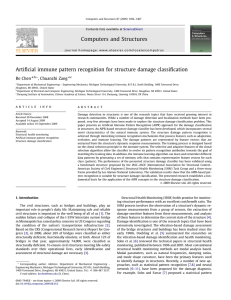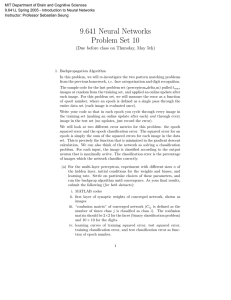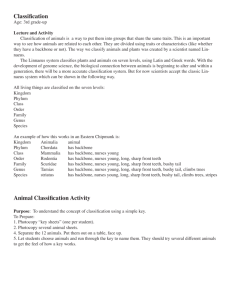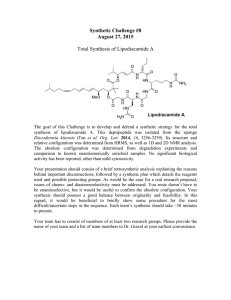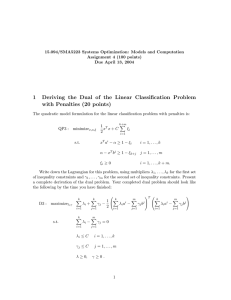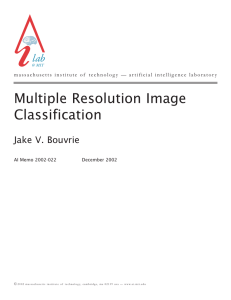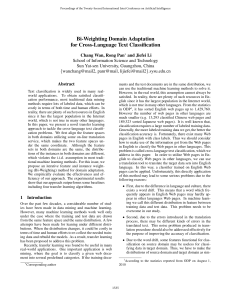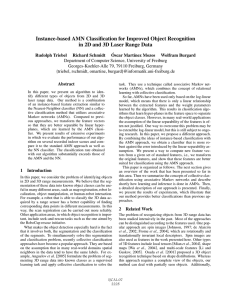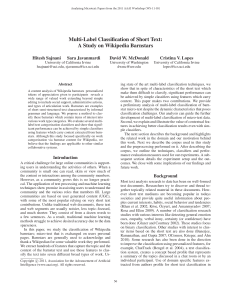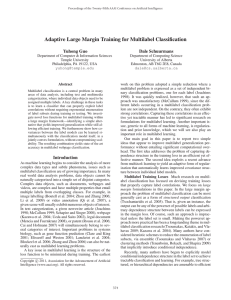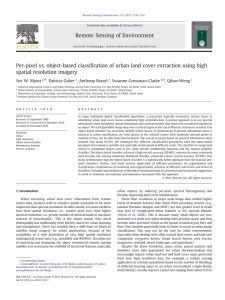Efficient pattern synthesis for nearest neighbour classifier Rapid and brief communication
advertisement
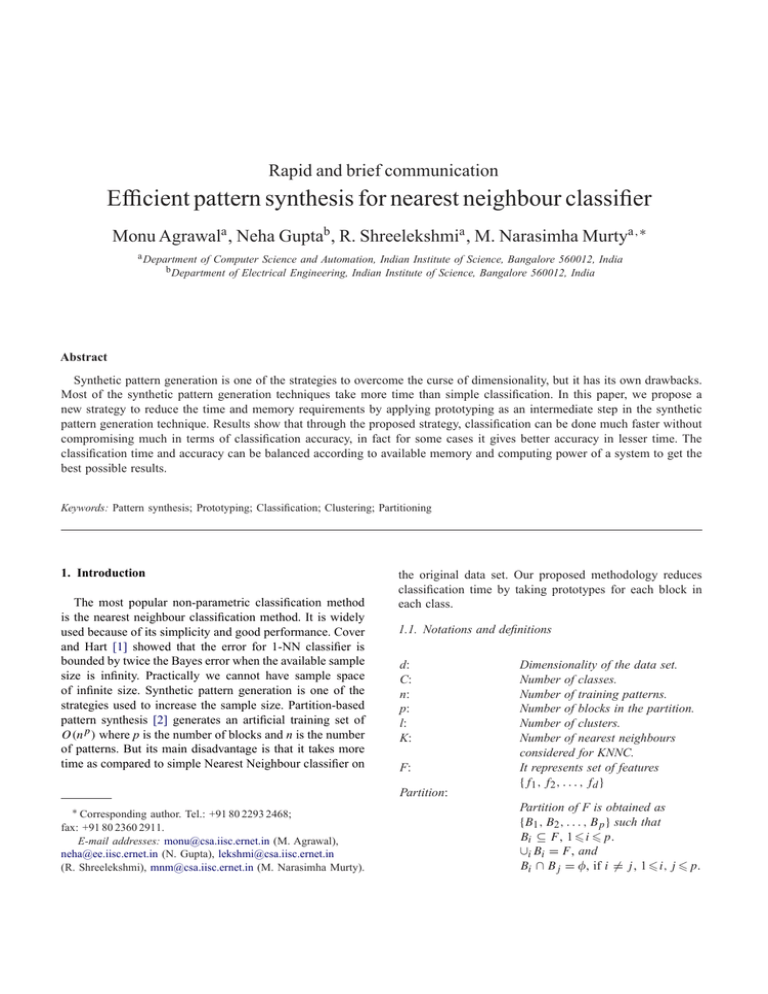
Rapid and brief communication
Efficient pattern synthesis for nearest neighbour classifier
Monu Agrawala , Neha Guptab , R. Shreelekshmia , M. Narasimha Murtya,∗
a Department of Computer Science and Automation, Indian Institute of Science, Bangalore 560012, India
b Department of Electrical Engineering, Indian Institute of Science, Bangalore 560012, India
Abstract
Synthetic pattern generation is one of the strategies to overcome the curse of dimensionality, but it has its own drawbacks.
Most of the synthetic pattern generation techniques take more time than simple classification. In this paper, we propose a
new strategy to reduce the time and memory requirements by applying prototyping as an intermediate step in the synthetic
pattern generation technique. Results show that through the proposed strategy, classification can be done much faster without
compromising much in terms of classification accuracy, in fact for some cases it gives better accuracy in lesser time. The
classification time and accuracy can be balanced according to available memory and computing power of a system to get the
best possible results.
Keywords: Pattern synthesis; Prototyping; Classification; Clustering; Partitioning
1. Introduction
The most popular non-parametric classification method
is the nearest neighbour classification method. It is widely
used because of its simplicity and good performance. Cover
and Hart [1] showed that the error for 1-NN classifier is
bounded by twice the Bayes error when the available sample
size is infinity. Practically we cannot have sample space
of infinite size. Synthetic pattern generation is one of the
strategies used to increase the sample size. Partition-based
pattern synthesis [2] generates an artificial training set of
O(np ) where p is the number of blocks and n is the number
of patterns. But its main disadvantage is that it takes more
time as compared to simple Nearest Neighbour classifier on
the original data set. Our proposed methodology reduces
classification time by taking prototypes for each block in
each class.
1.1. Notations and definitions
d:
C:
n:
p:
l:
K:
F:
Partition:
∗ Corresponding author. Tel.: +91 80 2293 2468;
fax: +91 80 2360 2911.
E-mail addresses: monu@csa.iisc.ernet.in (M. Agrawal),
neha@ee.iisc.ernet.in (N. Gupta), lekshmi@csa.iisc.ernet.in
(R. Shreelekshmi), mnm@csa.iisc.ernet.in (M. Narasimha Murty).
Dimensionality of the data set.
Number of classes.
Number of training patterns.
Number of blocks in the partition.
Number of clusters.
Number of nearest neighbours
considered for KNNC.
It represents set of features
{f1 , f2 , . . . , fd }
Partition of F is obtained as
{B1 , B2 , . . . , Bp } such that
Bi ⊆ F , 1 i p.
∪i Bi = F , and
Bi ∩ Bj = , if i = j , 1 i, j p.
where Bi is the ith block.
Merge Operation () :
If P and Q are two sub-patterns in blocks
Bi and Bj , respectively, where i = j , then
merge of P and Q written as P Q is a
sub-pattern in Bi ∪ Bj .
1.2. Partition-based pattern synthesis
Partition-based [2] pattern synthesis is a bootstrap
method which generates an artificial training set of O(np )
so as to improve the accuracy of the classifier when not
enough training data is available. This method is based
on partitioning of the data set and the synthetic patterns
are obtained as combinations of these partitions. The
partition-based pattern synthesis using Greedy KNNC
approach (GDC-KNNC) is explained in Algorithm 1.
Algorithm 1. Greedy KNNC for partition-based synthetic patterns
Let T be the test pattern to be classified.
Apply the partitioning on the training data set and T.
for each block Bj do
find the k-nearest neighbours in each class.
end for
Combine all ith nearest neighbour blocks in a class
to obtain a single pattern and thus generate k ∗ C synthetic patterns.
Find global k-nearest neighbours from the new synthetic patterns obtained.
Apply KNNC to classify the pattern.
1.3. Prototype selection
The intention of prototype selection [3] is to reduce the
data set size and arrive at most promising data representatives by eliminating outliers. The main drawbacks of having
large data set size are the following:
Time complexity: The efficiency of KNN Classifier is
O(n). So, as the size of data increases, the time needed by
the algorithm also increases.
Resources: KNN classifier needs to have the complete
data set stored in memory to carry out classification. If the
size of the data set is very large, the computer would need
to use the disk as swap memory. This loss of resources has
an adverse effect on efficiency due to the increased access
to the disk.
Sensitivity to noise: KNN classifier is sensitive to noise
due to its operation on local neighbourhood only. Presence
of outliers causes reduction in accuracy obtained.
In this paper, we have applied prototype selection
by replacing the large data set by a subset of cluster
representatives.
2. Proposed strategy
The original training data used for classification of a test
pattern contains a large number of patterns that may include
noise and outliers. Now if we apply any synthetic pattern
generation technique on this data, many unnecessary patterns are formed. This reduces the accuracy and increases the
testing time. In this paper, we have applied prototype selection by replacing the large data set by a smaller set of cluster representatives. The proposed method reduces the testing time by using prototypes of the training data set rather
than the training data itself. The training data is partitioned
into blocks. Then for every class, clusters of each block are
formed. Clustering is done separately on each block and not
on the data as a whole as the features in a particular partition are more correlated as compared to features in different partitions. The centroids of the clusters so obtained are
used as data representatives. The synthetic patterns are generated from the compact representation of data. The method
is explained in Algorithms 2 and 3.
Algorithm 2 Training
for each class Ci do
Obtain the partition i of feature set F and apply this partitioning on training data to obtain
blocks B1 , B2 , . . . , Bp .
for each block Bj do
Perform clustering on training data and get
cluster representatives as R1 , R2 , . . . , Rl .
end for
end for
Algorithm 3 Testing
Apply the same partitioning on test pattern.
for each class Ci do
for
each
block
Bj
do
Find k nearest neighbours of corresponding
test sub-pattern as: {Xji 1 , Xji 2 , . . . , Xji k }
from R1 , R2 , . . . , Rl .
end for
Obtain {S1i , S2i , . . . , Ski } as:
for l = 1 to k do
i X i · · · X i where is merge
Sli = X1l
2l
pl
operation [2].
end for
end for
Apply any nearest neighbour classification on the
above obtained k ∗ C synthetic patterns to label the
test pattern.
Fig. 1. Classification accuracy vs. no. of clusters.
Fig. 2. Classification accuracy vs. testing time.
3. Experimental results
We have applied the proposed strategy on OCR data [2]
having 667 patterns per class. We measured clustering time,
testing time and accuracy (%) varying K from 4 to 10 and
number of clusters from 25 to 645. The results are shown
in the graphs. We have obtained the maximum accuracy of
96.28% at K = 10 and number of clusters = 245. Fig. 1
Table 1
Accuracy vs. K
K
Accuracy(%)
2
3
4
6
12
16
95.68
96.28
95.41
92.14
92.5
89.92
Table 1 shows classification accuracy(%) measured
against different partitions. We have obtained highest accuracy for partition with 3 blocks. Table 2 compares the
proposed strategy with partition-based pattern synthesis [2]
and KNNC. It can be seen that with little memory (such as
25 clusters per class) and less classification time the strategy is able to classify the data with a good accuracy. As
compared with KNNC proposed strategy is approximately
10 times faster and also yields better classification accuracy.
4. Conclusion
Table 2
Comparison with partition-based pattern synthesis
KNNC
GDC-KNNC
With prototyping
With prototyping
With prototyping
K
Clusters
Accuracy(%)
Time(s)
7
8
10
5
4
—
—
245
55
25
93.63
96.04
96.28
95.59
94.51
10.03
19.08
14.55
2.26
1.001
shows accuracy (%) vs. number of clusters for different values of K. Fig. 2 plots accuracy vs. testing time for different
values of K. It depicts that at low values of parameters (such
as K = 4 and number of clusters = 25) we are able to attain
a high accuracy of 94.51% in 1.009 s. With testing time of
2.26 s (with K = 5, number of clusters = 55), we are able
to achieve an accuracy of 95.59%. We can observe that the
increase in accuracy with increase in number of clusters or
increase in value of K is not much.
In this paper, we have proposed a more efficient method
for pattern classification using partition-based pattern synthesis. Our experimental results show that when compared
with partition-based pattern synthesis, the proposed method
takes less classification time without much reduction in classification accuracy and in fact in some cases it gives better
classification accuracy. This strategy is useful in applications with memory and time constraints such as in handheld
devices.
References
[1] T.M. Cover, P.E. Hart, Nearest neighbour pattern classification,
IEEE Trans. Inf. Theory 13 (1) (1967) 21–27.
[2] P. Viswanath, M.N. Murty, S. Bhatnagar, Fusion of multiple
approximate nearest neighbor classifiers for fast and efficient
classification, Inf. Fusion 5 (2004) 239–250.
[3] T.R. Babu, M.N. Murty, Comparison of genetic algorithm based
prototype selection scheme, Pattern Recognition 34 (2) (2001)
523–525.
